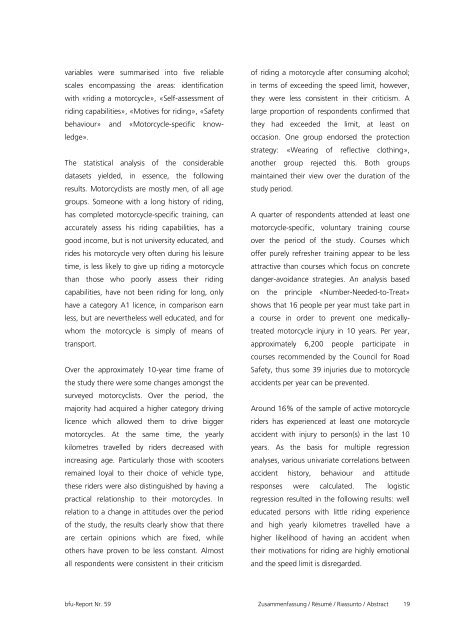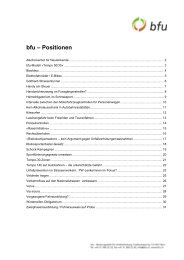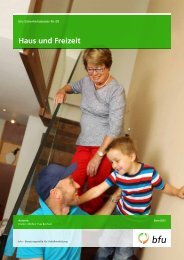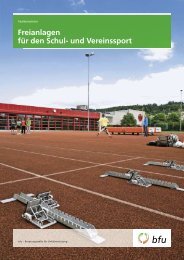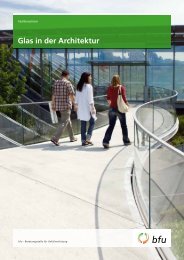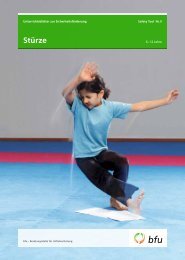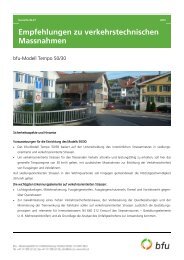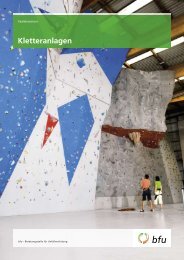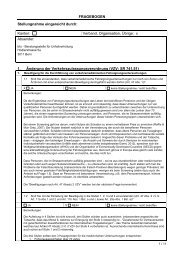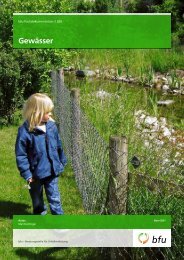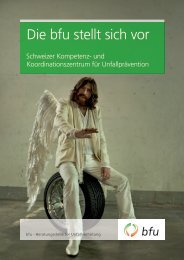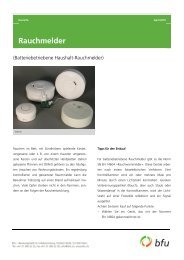Verhalten, Einstellungen und Unfallerfahrungen von ... - BfU
Verhalten, Einstellungen und Unfallerfahrungen von ... - BfU
Verhalten, Einstellungen und Unfallerfahrungen von ... - BfU
Erfolgreiche ePaper selbst erstellen
Machen Sie aus Ihren PDF Publikationen ein blätterbares Flipbook mit unserer einzigartigen Google optimierten e-Paper Software.
variables were summarised into five reliable<br />
scales encompassing the areas: identification<br />
with «riding a motorcycle», «Self-assessment of<br />
riding capabilities», «Motives for riding», «Safety<br />
behaviour» and «Motorcycle-specific know-<br />
ledge».<br />
The statistical analysis of the considerable<br />
datasets yielded, in essence, the following<br />
results. Motorcyclists are mostly men, of all age<br />
groups. Someone with a long history of riding,<br />
has completed motorcycle-specific training, can<br />
accurately assess his riding capabilities, has a<br />
good income, but is not university educated, and<br />
rides his motorcycle very often during his leisure<br />
time, is less likely to give up riding a motorcycle<br />
than those who poorly assess their riding<br />
capabilities, have not been riding for long, only<br />
have a category A1 licence, in comparison earn<br />
less, but are nevertheless well educated, and for<br />
whom the motorcycle is simply of means of<br />
transport.<br />
Over the approximately 10-year time frame of<br />
the study there were some changes amongst the<br />
surveyed motorcyclists. Over the period, the<br />
majority had acquired a higher category driving<br />
licence which allowed them to drive bigger<br />
motorcycles. At the same time, the yearly<br />
kilometres travelled by riders decreased with<br />
increasing age. Particularly those with scooters<br />
remained loyal to their choice of vehicle type,<br />
these riders were also distinguished by having a<br />
practical relationship to their motorcycles. In<br />
relation to a change in attitudes over the period<br />
of the study, the results clearly show that there<br />
are certain opinions which are fixed, while<br />
others have proven to be less constant. Almost<br />
all respondents were consistent in their criticism<br />
of riding a motorcycle after consuming alcohol;<br />
in terms of exceeding the speed limit, however,<br />
they were less consistent in their criticism. A<br />
large proportion of respondents confirmed that<br />
they had exceeded the limit, at least on<br />
occasion. One group endorsed the protection<br />
strategy: «Wearing of reflective clothing»,<br />
another group rejected this. Both groups<br />
maintained their view over the duration of the<br />
study period.<br />
A quarter of respondents attended at least one<br />
motorcycle-specific, voluntary training course<br />
over the period of the study. Courses which<br />
offer purely refresher training appear to be less<br />
attractive than courses which focus on concrete<br />
danger-avoidance strategies. An analysis based<br />
on the principle «Number-Needed-to-Treat»<br />
shows that 16 people per year must take part in<br />
a course in order to prevent one medically-<br />
treated motorcycle injury in 10 years. Per year,<br />
approximately 6,200 people participate in<br />
courses recommended by the Council for Road<br />
Safety, thus some 39 injuries due to motorcycle<br />
accidents per year can be prevented.<br />
Aro<strong>und</strong> 16% of the sample of active motorcycle<br />
riders has experienced at least one motorcycle<br />
accident with injury to person(s) in the last 10<br />
years. As the basis for multiple regression<br />
analyses, various univariate correlations between<br />
accident history, behaviour and attitude<br />
responses were calculated. The logistic<br />
regression resulted in the following results: well<br />
educated persons with little riding experience<br />
and high yearly kilometres travelled have a<br />
higher likelihood of having an accident when<br />
their motivations for riding are highly emotional<br />
and the speed limit is disregarded.<br />
bfu-Report Nr. 59 Zusammenfassung / Résumé / Riassunto / Abstract 19


